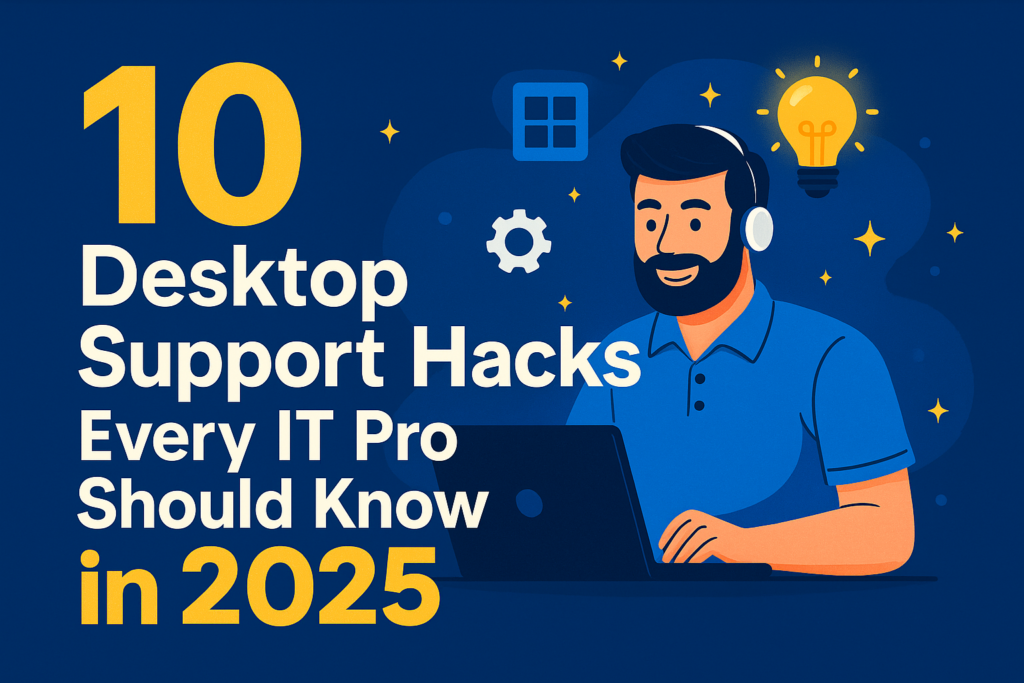10 Desktop Support Hacks Every IT Pro Should Know in 2025

In the fast-evolving tech environment of 2025, mastering desktop support is more than just solving everyday tech issues—it’s about working smarter, faster, and safer. Whether you’re in a small firm or part of a large enterprise, knowing these 10 essential hacks will make you the go-to expert for efficient and reliable desktop support services.
Introduction to Modern Desktop Support Hacks Challenges
Desktop support today is vastly different from what it was even a few years ago. With the hybrid workforce model, rising cybersecurity concerns, and complex software ecosystems, IT support professionals need more than just basic troubleshooting skills.
Many are now pursuing desktop support certification or advanced desktop support technician certification to stay competitive and prepared for modern workplace challenges.
Common challenges include:
- Supporting remote and hybrid users
- Managing a variety of operating systems and devices
- Ensuring secure, real-time solutions
- Meeting growing compliance demands
Hack #1: Use Automated Scripts for Routine Tasks
Automation is the future. By using tools like PowerShell, Bash, or Python scripts, you can eliminate repetitive tasks and reduce human error.
Examples of scriptable tasks:
- Bulk software installations
- Scheduled cache cleanups
- Remote shutdowns
- Mapping network drives
These scripts are invaluable IT support tools that save time and boost your team’s efficiency.
Hack #2: Leverage Remote Access Tools Effectively
Remote access has become an essential component of professional desktop support. Tools like AnyDesk, TeamViewer, and Microsoft Remote Desktop allow you to provide instant help—whether you’re across the building or the world.
Best practices:
- Always enable two-factor authentication
- Record sessions for compliance and training
- Limit permissions based on user roles
For anyone working in certified IT support, mastering remote tools is a non-negotiable skill.
Hack #3: Mastering Keyboard Shortcuts for Speed
Every second counts in a support ticket. Learning and using keyboard shortcuts can drastically speed up your responses.
Essential Windows Shortcuts:
Ctrl + Shift + Esc– Task ManagerWindows + R– Run dialogAlt + Tab– Switch apps
macOS Shortcuts:
Cmd + Space– SpotlightCmd + Shift + 4– Screenshot
Custom shortcuts using tools like AutoHotKey also help enhance speed and consistency.
Hack #4: Centralized Patch Management
Patching manually is outdated. With centralized tools like WSUS, ManageEngine, or PDQ Deploy, you can ensure consistent updates across hundreds of machines.
Why it matters:
- Patches close security loopholes
- Reduces compliance risks
- Saves hours per month
Effective patching strategies are a core skill for anyone seeking a desktop support technician certification.
Hack #5: Use System Restore Points Wisely
Setting system restore points before making changes is a lifesaver. These create a snapshot of your machine, allowing you to roll back if anything goes wrong.
Best practices:
- Automate restore points weekly
- Create manually before big installs
- Clean up old points to save space
These techniques are often covered in desktop support certification training programs as part of system resilience.
Hack #6: Maintain a Local Software Repository
Having a network-shared folder with installers for frequently used applications can drastically reduce setup time.
Include in your repository:
- Antivirus programs
- Office suites
- Drivers and firmware updates
- VPN and remote tools
Use solutions like Chocolatey, Ninite Pro, or custom deployment scripts to manage the repository efficiently. This is a hallmark of professional desktop support.
Hack #7: Network Troubleshooting Like a Pro
Understanding basic networking commands is essential for diagnosing issues quickly.
Useful commands:
ping– Check connectivityipconfig /release&renew– Refresh IP settingstracert– Analyze connection path
For any desktop support technician, network skills go hand-in-hand with excellent IT support tools.
Hack #8: Minimize Downtime with Virtual Machines
Virtual Machines (VMs) let you safely test patches, applications, and configuration changes without affecting live systems.
Use VMs to:
- Simulate user environments
- Train new team members
- Test legacy software
Most certified IT support teams maintain VM labs to ensure they’re always ready to tackle complex issues without disruption.
Hack #9: Document Every Solution You Implement
Documentation transforms your experience into institutional knowledge. From ticketing systems to internal wikis, it’s key to sustainable support.
Documentation platforms:
- Confluence
- Notion
- Google Docs
- Zendesk or Freshdesk for ticket notes
Well-documented solutions can also assist newer team members pursuing desktop support technician certification.
Hack #10: Monitor System Health Proactively
Why wait for a user to report a problem? Use real-time system monitoring tools like SolarWinds, PRTG, and Zabbix.
What to monitor:
- CPU and memory usage
- Disk health
- Security events
- Network performance
By detecting anomalies early, you become a proactive rather than reactive desktop support professional.
Bonus Tips: Staying Ahead in IT Support
If you’re serious about making a long-term impact in desktop support services, stay sharp with ongoing education and networking.
Recommendations:
- Earn certifications: CompTIA A+, Microsoft Certified Desktop Support Technician
- Join online communities: Reddit’s r/sysadmin, Spiceworks, and TechNet
- Stay updated with IT blogs and webinars
Whether you’re just starting out or looking to upgrade, becoming a certified IT support expert opens new career doors.
FAQs
1. Why is desktop support certification important in 2025?
It validates your skills, proves your commitment, and opens up more job opportunities in competitive IT environments.
2. What’s the difference between desktop support and professional desktop support?
Professional desktop support goes beyond basic helpdesk tasks. It involves documentation, compliance, security, and often requires certification.
3. Are there any free tools to help with desktop support services?
Yes! Tools like Ninite, TeamViewer (free for personal use), and Microsoft Sysinternals Suite are great for starters.
4. How do I become a certified IT support professional?
You can start with CompTIA A+ or Microsoft’s certification paths. Practice labs and hands-on experience are essential.
5. What are some top IT support tools every technician should have?
PowerShell, Ninite Pro, PRTG, Remote Desktop, and documentation tools like Notion or Confluence are must-haves.
6. How do I balance speed and quality in desktop support?
Use automation, document your work, and master shortcuts. The more consistent your process, the better your results.
Conclusion
As an IT pro, the key to thriving in 2025 lies in mastering the tools and tricks of the trade. These 10 desktop support hacks—along with the right certifications and best practices—equip you to deliver faster resolutions, safer environments, and superior user satisfaction.
Whether you’re already certified or just starting your journey in desktop support, keep evolving. Learn, adapt, and automate—and you’ll always be ahead of the curve.




No comment